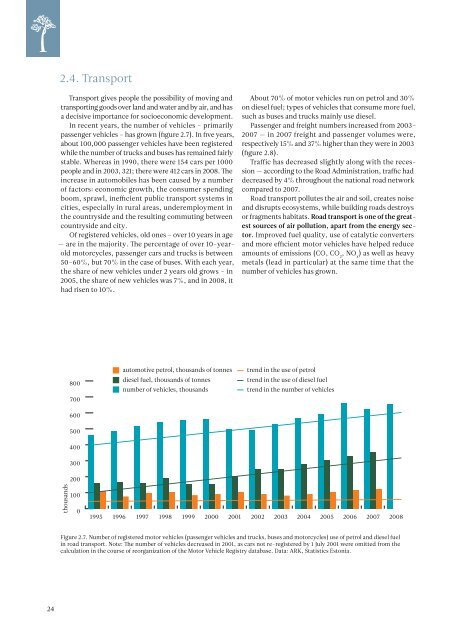ESTONIAN ENVIRONMENTAL REVIEW 2009
ESTONIAN ENVIRONMENTAL REVIEW 2009
ESTONIAN ENVIRONMENTAL REVIEW 2009
You also want an ePaper? Increase the reach of your titles
YUMPU automatically turns print PDFs into web optimized ePapers that Google loves.
2.4. Transport<br />
Transport gives people the possibility of moving and<br />
transporting goods over land and water and by air, and has<br />
a decisive importance for socioeconomic development.<br />
In recent years, the number of vehicles – primarily<br />
passenger vehicles – has grown (figure 2.7). In five years,<br />
about 100,000 passenger vehicles have been registered<br />
while the number of trucks and buses has remained fairly<br />
stable. Whereas in 1990, there were 154 cars per 1000<br />
people and in 2003, 321; there were 412 cars in 2008. The<br />
increase in automobiles has been caused by a number<br />
of factors: economic growth, the consumer spending<br />
boom, sprawl, inefficient public transport systems in<br />
cities, especially in rural areas, underemployment in<br />
the countryside and the resulting commuting between<br />
countryside and city.<br />
Of registered vehicles, old ones – over 10 years in age<br />
— are in the majority. The percentage of over 10-yearold<br />
motorcycles, passenger cars and trucks is between<br />
50–60%, but 70% in the case of buses. With each year,<br />
the share of new vehicles under 2 years old grows – in<br />
2005, the share of new vehicles was 7%, and in 2008, it<br />
had risen to 10%.<br />
About 70% of motor vehicles run on petrol and 30%<br />
on diesel fuel; types of vehicles that consume more fuel,<br />
such as buses and trucks mainly use diesel.<br />
Passenger and freight numbers increased from 2003–<br />
2007 — in 2007 freight and passenger volumes were,<br />
respectively 15% and 37% higher than they were in 2003<br />
(figure 2.8).<br />
Traffic has decreased slightly along with the recession<br />
— according to the Road Administration, traffic had<br />
decreased by 4% throughout the national road network<br />
compared to 2007.<br />
Road transport pollutes the air and soil, creates noise<br />
and disrupts ecosystems, while building roads destroys<br />
or fragments habitats. Road transport is one of the greatest<br />
sources of air pollution, apart from the energy sector.<br />
Improved fuel quality, use of catalytic converters<br />
and more efficient motor vehicles have helped reduce<br />
amounts of emissions (CO, CO 2<br />
, NO x<br />
) as well as heavy<br />
metals (lead in particular) at the same time that the<br />
number of vehicles has grown.<br />
800<br />
700<br />
600<br />
automotive petrol, thousands of tonnes<br />
diesel fuel, thousands of tonnes<br />
number of vehicles, thousands<br />
trend in the use of petrol<br />
trend in the use of diesel fuel<br />
trend in the number of vehicles<br />
500<br />
400<br />
300<br />
200<br />
thousands<br />
100<br />
0<br />
1995 1996 1997 1998 1999 2000 2001 2002 2003 2004 2005 2006 2007 2008<br />
Figure 2.7. Number of registered motor vehicles (passenger vehicles and trucks, buses and motorcycles) use of petrol and diesel fuel<br />
in road transport. Note: The number of vehicles decreased in 2001, as cars not re-registered by 1 July 2001 were omitted from the<br />
calculation in the course of reorganization of the Motor Vehicle Registry database. Data: ARK, Statistics Estonia.<br />
24

















